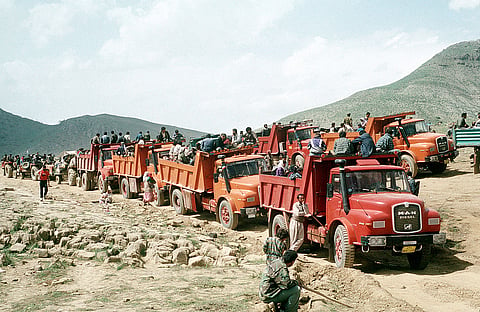

By Atul Singh
Millions are fleeing their homelands for their lives, and hundreds of millions are leaving ancestral villages for cities in search of better lives.
Homo sapiens is the Latin name for the subspecies that human beings belong to. Apparently, this subspecies originated in East Africa and migrated to the rest of the planet. It seems that to migrate is to be human.
People have always migrated in search of greener pastures, fertile soils, temperate climes, metals, spices and more. The Mongols thundered across vast steppes on their galloping steeds. The Arabs reached both Sind and Spain in the blink of an eye. Even in the early days of the first human civilizations, Mesopotamians and Indus Valley natives settled in each other’s lands. More recently, the 19th century was a period of European expansion. White Europeans turned up to claim land from the Native Americans, Aborigines, Maoris, Africans and Asians to bring “civilization” to these places.
Today, migration across continents and borders has a different hue. In the Americas, Latin Americans from countries like Mexico, Guatemala and El Salvador are streaming into the United States and even Canada. They clean toilets, mow lawns, repair cars and do the odd jobs that keep the US economy ticking. Europe is the key destination for migrants from the Middle East, North Africa and Sub-Saharan Africa who are fleeing hunger, persecution and war. Germany alone has received 179,000 asylum applications in the first six months of 2015. Smaller countries like Austria will be receiving 80,000 applications this year. Unsurprisingly, Werner Faymann, the Austrian chancellor, has described the migrant crisis as “Europe’s biggest challenge.”
In the US, immigration is turning out to be a key issue in the 2016 Presidential Election race. Donald Trump has come out with all guns blazing against illegal immigrants. The brash billionaire is leading the Republican primaries and wants a wall on the Mexican border to keep out immigrants. He has popularized the term “anchor baby” that has been used by rival Jeb Bush as well. The term refers to immigrants deciding to have babies in the US because the 14th Amendment to the Constitution grants citizenship to anyone born in the US. Trump and other candidates are playing on the fears of aging white Americans who dread the day when they will be in a minority in the US.
In India, immigration from Bangladesh is vexing local populations and many politicians. States in the northeast of India such as Assam are seeing a massive demographic shift as Bangladeshis flee into India. The northeast of India has long been the region where the “brown” and “yellow” races mingle. The former tend to be Muslim, while the latter are mostly Christians. As the pressure on resources increases, race and religion are exacerbating tensions. In the rest of India, Bangladeshi immigration is causing unease because Hindus fear growing Muslim populations that bring back the specter of the country’s partition into India and Pakistan in 1947.
It is important to note that the greatest migration of our era is taking place from the villages to the cities. Hundreds of millions are on the march to huge urban centers as villages die by the thousands worldwide. This urbanization first began in England in the 19th century. From 1801 to 1891, the urban population of England rose from 17% to 72%. By now, urbanization has occurred in Europe and the US. The urban population in bankrupt Greece is 78%, 3% more than that of prosperous Germany. The figures for the US and Canada are 81% and 82% respectively. Now, the rest of the world is catching up. The World Urbanization Prospects, published by the United Nations, estimates that 66% of the world’s population in 2050 will be living in urban areas.
In China, hundreds of millions of villagers are marching into cities to work in factories that make everything from shoes to iPhones. Under China’s houkou system of household registration, most of these workers get a raw deal when they immigrate to cities. They work inordinately long hours in tough conditions for low pay and little vacation time. The Spring Festival is the one time in the year when they head home and reconnect with their roots. In the urban areas where they slave away, they do not qualify for social benefits such as health care or education for their children.
The rest of Asia is worse off than China. Slums in India, Pakistan and Bangladesh are infamous for their grinding poverty, abject living conditions and rampant disease. Those who leave behind villages to chase the urban dream often rue the nightmare of city life. Despite the pitfalls of urbanization, Dickensian England marches on. Already, Osaka, Karachi, Jakarta, Mumbai, Shanghai, Manila, Seoul and Beijing are home to over 20 million people—and their populations are growing.
While many are migrating to cities in search of a better life, others are fleeing for their lives. As of the end of 2014, a record-breaking 38 million people were forcibly displaced within their own country by violence that threatened their existence. Congo, Iraq, Nigeria, South Sudan and Syria caused 60% of the new displacement. As per the United Nations, nearly 60 million had to flee their homes because of war and persecution. This means that 22 million had to cross borders, and one in every 122 humans is now a refugee. This brings new challenges for humans from sanitation and disease prevention to social order and employment generation.
We are living in a new age of migration with hundreds of millions on the move. It is leading to upheaval, tension and even strife. Promise accompanies peril, and this unprecedented migration might force over 7 billion Homo sapiens sapiens to live more harmoniously on the planet.
The article was originally published by the Fair Observer.